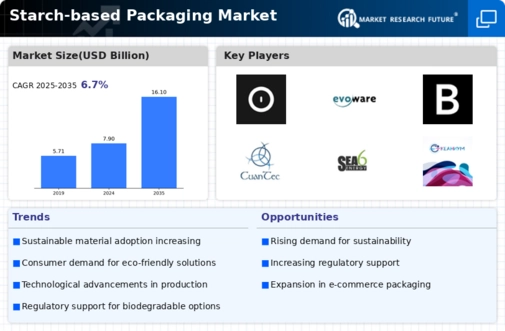Market Trends
Key Emerging Trends in the Starch based Packaging Market
The Starch-based Packaging market is now facing some key trends due to the growing need for sustainable and eco-friendly packaging solutions. Starch-based packaging materials, derived from renewable resources such as corn, potatoes, and cassava, has become more popular as replaceable and compostable alternative to conventional petroleum-based packaging materials. The other important trend in the market is the increase in the utilization of starch-based packaging in line with worldwide eco-friendly packaging solutions. With the prioritization of sustainability and as consumers and industries also turn to starch-based packaging as a sustainable alternative to reduce the environmental impact of packaging waste. It also matches the global shift towards circular economies and the concept of reduce, reuse and recycle.
In addition, the market for starch-based packaging is seen expanding in the food and beverage sector. Starchy materials in production of flexible films, trays and containers to be used for packaging food are being employed. The degradability of starch-based packaging offers a sustainable option for food packaging and supports the industry’s endeavor to reduce its ecological left behind. This trend is a result of the growing consumer awareness and demand for eco-friendly packaging materials in the production of food and beverages.
Besides that, the starch-based packaging market is affected by the technological growth in materials and more research and development efforts. The manufacturers are trying new formulations and new processing techniques to improve the performance, barrier properties and shelf life. These advancements tackle moisture resistance and mechanical strength problems so that starch-based materials can become applicable in packaging for different industries and markets. This direction is in line with the ongoing efforts of achieving sustainable packaging that does not compromise on functionality or performance.
Additionally, the starch-based packaging market is gaining popularity with regulations and industry initiatives in the government regarding sustainable packaging being implemented. Regulatory authorities worldwide are implementing initiatives to limit the production of single-use plastics and encourage the installation of eco-friendly options. Moreover, industry associations and organizations are onboard the campaign on awareness and sustainability that urge businesses to make use of starch-based packaging options. This trend is a result of joining hands to achieve a greener and more responsible packaging world.










Leave a Comment